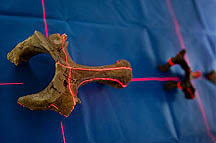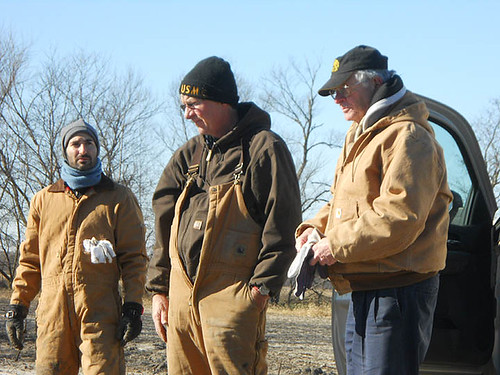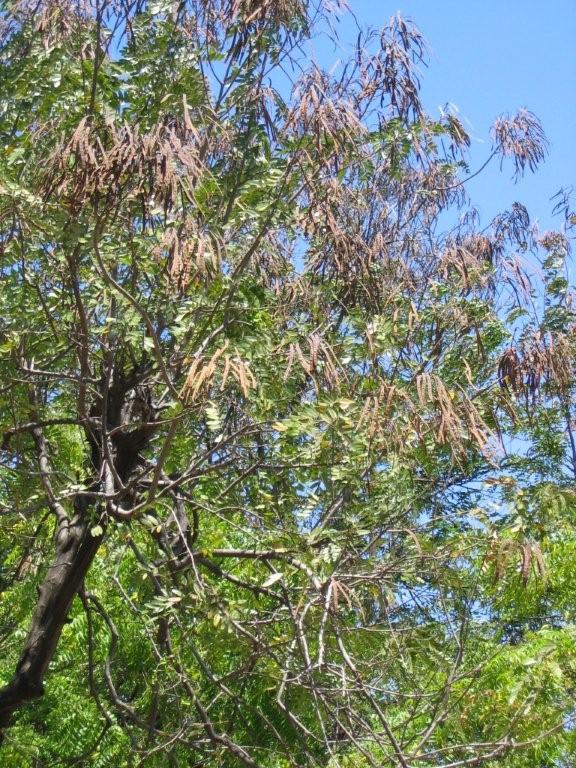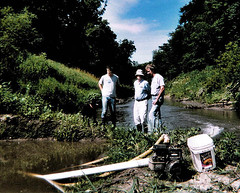 We took the sloth show on the road April 1 and travelled to Macomb, IL for the 2012 MAPS Expo. Here’s a link to some of the photos. Many thanks to my wife and veteran slother Lynette who stepped in at the last minute to help out. Tried out many of the lessons in the Museum’s upcoming traveling trunk of sloth fossil-prototypes. Tremendous reception . . . Dave
We took the sloth show on the road April 1 and travelled to Macomb, IL for the 2012 MAPS Expo. Here’s a link to some of the photos. Many thanks to my wife and veteran slother Lynette who stepped in at the last minute to help out. Tried out many of the lessons in the Museum’s upcoming traveling trunk of sloth fossil-prototypes. Tremendous reception . . . Dave
Author Archives: a.update.wordpress.org
Prototyping project photo essay
 Friday the University published a photo essay in their on-line journal FYI about the rapid prototyping process we are using to duplicate bones on the Tarkio Valley Sloth Project. The prototypes (a.k.a. “casts”) are accurate within a millimeter and can be safely mailed to scientists who wish to examine the individual elements for their research. They will also serve as substitute bones for traveling trunks to schools and nature centers that we plan to make available in 2012. The prototypes may also be the basis of a sloth exhibit in the Greater Shenandoah Historical Museum someday.
Friday the University published a photo essay in their on-line journal FYI about the rapid prototyping process we are using to duplicate bones on the Tarkio Valley Sloth Project. The prototypes (a.k.a. “casts”) are accurate within a millimeter and can be safely mailed to scientists who wish to examine the individual elements for their research. They will also serve as substitute bones for traveling trunks to schools and nature centers that we plan to make available in 2012. The prototypes may also be the basis of a sloth exhibit in the Greater Shenandoah Historical Museum someday.Radiocarbon date update
Another attempt for a direct radiocarbon date on the Tarkio Valley sloths failed. Bob Feranec reports that the National Ocean Sciences AMS (Accelerator Mass Spectrometry) Facility at the Woods Hole Oceanographic Institution could not obtain a sufficient quantity of CO2 from the 2.5 milligram collagen sample that he collected via seven extractions from a molariform.
Megalonyx Matters 23: Sloth Site Coring
Dave and I met Dr. Art Bettis, Department of Geoscience, University of Iowa, and Dr. Adel ‘Eddie’ Haj and his graduate assistant Harold Ray, Department of Biology and Earth Science, University of Central Missouri, at 8:00 AM, November 23, 2010 in Shenandoah and drove to the Tarkio Valley site to core the sloth locality with a Giddings trailer- mounted rig. AM temperatures started at 16 degrees and stayed below freezing all day. Frozen farm fields made access easy despite the previous week’s heavy rainfall.
and Dr. Adel ‘Eddie’ Haj and his graduate assistant Harold Ray, Department of Biology and Earth Science, University of Central Missouri, at 8:00 AM, November 23, 2010 in Shenandoah and drove to the Tarkio Valley site to core the sloth locality with a Giddings trailer- mounted rig. AM temperatures started at 16 degrees and stayed below freezing all day. Frozen farm fields made access easy despite the previous week’s heavy rainfall.
digging this weekend
Hi All,
We have the crawler reserved for this Friday to prepare the Tarkio Valley site for a dig on Saturday. This could last into Sunday (but not likely). We will meet at the Days Inn parking lot at 7:30 on Saturday September 12 and caravan to the site. We will provide water, sunscreen and Deet. You should bring your own light tools (trowel, etc.). Dave, Will and I believe that we have dug up to the north bank excavation cleared a few years ago but that bone may still lie below one of our old levees. This area will be the target this trip. Will should have the overburden cleaned down to this level by Friday afternoon. Sloth on. Holmes
Gazette honors Museum and Giant Sloth
 The UI Museum of Natural History received some well-deserved recognition in the May 11, 2009 issue of the Cedar Rapids Gazette. In their Homers/Gomers column, under what’s going right, The Gazette called the Museum a “NATURAL TREASURE.”
The UI Museum of Natural History received some well-deserved recognition in the May 11, 2009 issue of the Cedar Rapids Gazette. In their Homers/Gomers column, under what’s going right, The Gazette called the Museum a “NATURAL TREASURE.”
“The University of Iowa’s Museum of Natural History may be one of the state’s best-kept secrets. The museum marked its 150th year last week, and its mission as a teaching and research tool is still intact. The 1,000,000-item collection compiled by UI faculty and students during research expeditions, includes a signature giant ground sloth display from a major excavation near Shenandoah.”
Good Going Museum! (For the record, Rusty and display were constructed long before our Shenandoah discovery, but they are right about him/her being the same species.) Sloth on. Holmes.
Photos preparing the site last week
The week of July 6 was predicted to be sunny and apparently an ideal time for a two day excavation to recover additional remains of the baby and toddler discovered at the end of the May dig. As in the past, Evans Rental hauled the rented crawler to the site a day in advance. Will Mott arrived mid-morning with a large gas-powered pump which rapidly pumped the accumulated water from inside the levee. He estimated the capacity at about 100 gallons/minute. After the pit was ‘dry,’ Will relocated the levee protecting the previous dig north about 12 feet and then removed the muck resulting from two floods from off the floor of the excavation area. This was accomplished by 7:00 PM. Unfortunately, overnight thunderstorms produced heavy rains which lasted into the following day. While the creek did not overtop the levee, the rain was sufficient to flood the excavation and render the area inaccessible for the pump, crawler and people. More storms were predicted later in the day. The volunteers vowed to return as soon as possible after the area dried. Participants were William Mott, Lee McNair, Bill Wiechman, Aaron Last, David Brenzel and Holmes Semken.
Holmes Semken and David Brenzel, July 9, 2009.
dig cancelled
It was susposed to be clear this afternoon but a big thunderstorm around 10:30 made the locality unworkable. We will start again as soon as it looks like we have a dry period. Sloth on, Holmes
May 7 program details
Sloth Volunteers,
There will be a special program featuring the Tarkio Valley sloths kicking off the 150th anniversary of the Museum of Natural History, University of Iowa during the afternoon and evening of Thursday, May 7.
First, there will be an open house in the Paleontological Repository, where the University’s paleontological collection is housed, from 3:00-5:00 PM. This is informal and you can visit as you wish. Staff will be present to answer questions. This will be held in Trowbridge Hall which is one building north of the Pentacrest (Old Capitol area) and next to the Union parking ramp.
Ghosts on a subcontinent
 I found an interesting parallel to the honey locust story featured in “Sloth Music” in the central square of Granada, Nicaragua where there was a tree with seed pods that looked like those of a honey locust (the leaves are different). I asked our guide about it and he said that it was a melinche tree. He knew his stuff because he wrote the genus and species (Delonix regia) on the back of an envelope. He noted that as a child he and his friends would climb the melinches to collect the longest seed pods which invariably were at the top of the tree. They used them as swords because they liked the accompanying rattle (dinner bells!) during their games. I googled the tree and found that they are in the same family (Fabaceae) as the honey locust. Delonix is now endangered in the wild but is spread worldwide in the tropics as an ornamental tree, the Royal Poinciana. Recall that the honey locust also had a restricted range until it became a popular shade tree in North America.
I found an interesting parallel to the honey locust story featured in “Sloth Music” in the central square of Granada, Nicaragua where there was a tree with seed pods that looked like those of a honey locust (the leaves are different). I asked our guide about it and he said that it was a melinche tree. He knew his stuff because he wrote the genus and species (Delonix regia) on the back of an envelope. He noted that as a child he and his friends would climb the melinches to collect the longest seed pods which invariably were at the top of the tree. They used them as swords because they liked the accompanying rattle (dinner bells!) during their games. I googled the tree and found that they are in the same family (Fabaceae) as the honey locust. Delonix is now endangered in the wild but is spread worldwide in the tropics as an ornamental tree, the Royal Poinciana. Recall that the honey locust also had a restricted range until it became a popular shade tree in North America.








